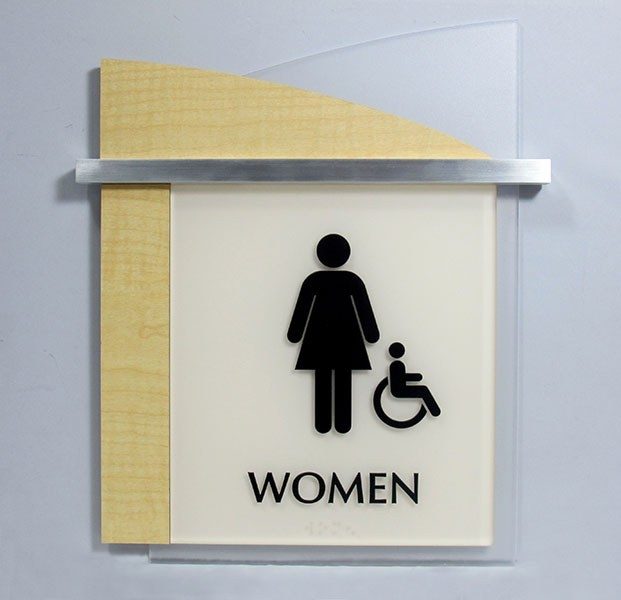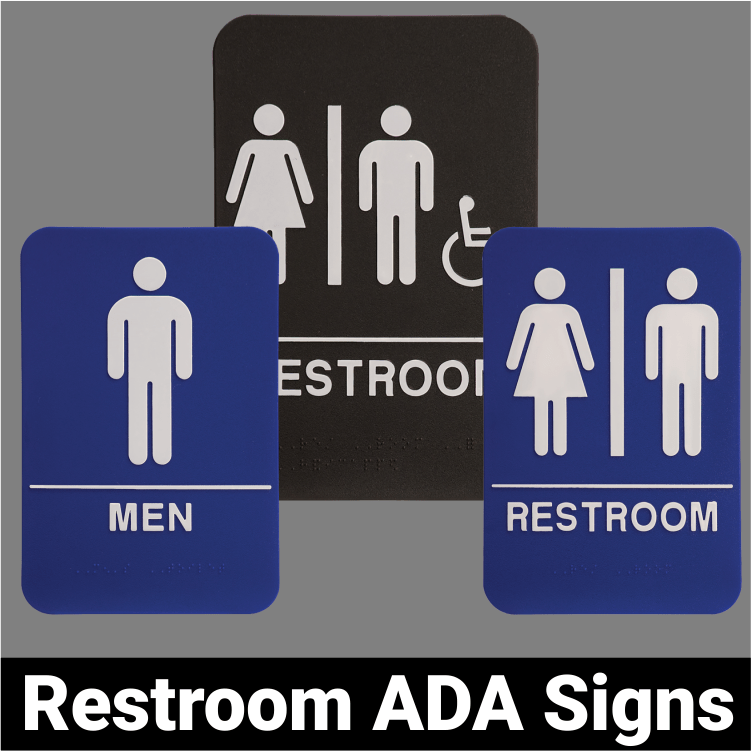ADA Signs: Ensuring Availability and Compliance in Public Spaces
ADA signs plays a crucial role in guaranteeing ease of access and compliance within public areas, substantially adding to a comprehensive setting for people with handicaps. As we explore the subtleties of ADA signs, from responsive attributes to make details, it's crucial to consider how these elements integrate to promote the civil liberties of all customers.
Relevance of ADA Signs
In modern-day society, the importance of ADA signage extends beyond plain conformity with lawful mandates to embody a commitment to inclusivity and accessibility for all people. These indicators are necessary in producing atmospheres where individuals with disabilities can browse public rooms with the very same simplicity and self-reliance as those without specials needs. By providing standard and clear info, ADA signage ensures that every person can access centers, services, and details without barriers.
The significance of ADA signs depends on its ability to improve the quality of life for individuals with specials needs by promoting equivalent access. It removes the challenges that might or else hinder their capacity to take part fully in neighborhood life. Additionally, these indicators function as noticeable signs of an organization's commitment to diversity and equal rights, reflecting wider societal worths that promote the legal rights and self-respect of all individuals.
Additionally, ADA signage plays a critical function in public safety and security. By directing people to exits, bathrooms, and various other vital centers, it guarantees that all individuals, no matter of physical ability, can evacuate securely throughout emergencies. In summary, ADA signs is not simply a regulatory demand yet an effective tool for promoting a equitable and inclusive society.
Crucial Element of Compliance

Positioning is important; indications must be installed in locations that are easily visible and reachable. Typically, signage should be placed in between 48 and 60 inches from the ground to make certain availability for both standing and mobility device customers. Responsive aspects, such as Braille, are necessary for individuals with visual disabilities, offering important details in a non-visual style.
High-contrast colors between the message and history are required to improve readability for individuals with reduced vision. The ADA mandates particular comparison proportions to guarantee quality. Furthermore, character size is a crucial factor to consider, with minimum elevation demands determined by the checking out distance to make certain readability from various angles.
Layout Considerations for Availability
Designing easily accessible signs needs a meticulous approach to guarantee it meets the demands of all individuals, particularly those with impairments. This involves considering various design aspects that enhance readability and use. Key aspects include the selection of typeface, shade contrast, and responsive features. Fonts should be sans-serif, with clear and simple letterforms, to help with easy analysis. The dimension of the text is equally vital, with ADA guidelines advising a minimal elevation based upon seeing distance to guarantee clarity.
Contrasting shades in between text and history are vital for presence, specifically for individuals with visual disabilities. A high comparison ratio aids identify the text from its background, boosting readability under numerous lights conditions. Furthermore, responsive aspects, such as Braille and elevated personalities, are essential for people that are blind or have reduced vision. These elements ought to be found at a constant height and placement to ensure very easy gain access to and understanding.
In addition, the placement of signage plays a significant function in ease of access. Signs need to be installed in places that are unhampered and conveniently reachable. Ensuring that signs is mounted at appropriate elevations and angles allows all users, including those making use of wheelchairs, to engage with them efficiently.
Usual Mistakes to Avoid

One more prevalent mistake is the incorrect placement of signs. ADA guidelines define exact elevation and area demands to ensure that indicators are obtainable and conveniently noticeable by all individuals, consisting of those making use of wheelchairs. Overlooking these standards not only interferes with accessibility yet also runs the risk of non-compliance with legal standards.
In addition, insufficient contrast in between message and background is a constant oversight. Sufficient comparison is necessary for readability, specifically for individuals with reduced company website vision. Developers often choose colors that are visually attractive but do not have the necessary comparison, providing the message tough to recognize.
Finally, some developers fail to incorporate responsive aspects, such as Braille, which are vital for people who are blind. Omitting these features not just causes non-compliance with ADA guidelines but additionally limits accessibility for a section of the populace that depends on tactile info.
Future Trends in Signage
Developments in technology and increasing recognition of inclusivity are forming the future trends in signs design. As culture becomes a lot more conscious of diverse needs, the combination of smart technologies right into signs is getting traction. Digital signage, as an example, is evolving to include interactive attributes and real-time updates, which can be essential in providing vibrant info in public areas. These signs typically integrate touch screens or gesture-based controls, making it possible for customers to browse content customized to their particular needs.
An additional emerging trend is the usage of augmented fact (AR) to improve individual experience. AR-enabled signage can overlay digital information onto the physical environment, offering aesthetically damaged individuals with auditory or haptic feedback. ADA Signs. This innovation not only improves access yet additionally produces an appealing experience for all users
Sustainability is likewise a significant element influencing signs fads. Environment-friendly materials and energy-efficient illumination options are being prioritized to line up with Our site worldwide ecological objectives. Innovations in materials scientific research are leading to the advancement of more sturdy and weather-resistant signs.
Conclusion
ADA signs plays an essential role in guaranteeing accessibility and compliance within public areas by including responsive aspects, high-contrast shades, and tactical positioning. The adherence to ADA criteria not just check out here assists in risk-free navigation for people with handicaps but also signifies a company's devotion to variety and inclusivity. By preventing common mistakes and embracing future patterns, public rooms can remain to advance these values, making certain that the rights and self-respect of all individuals are valued and supported.
ADA signage plays an indispensable role in assuring access and compliance within public areas, dramatically adding to an inclusive environment for individuals with disabilities. As we check out the subtleties of ADA signs, from tactile functions to design ins and outs, it's critical to think about how these elements coalesce to maintain the civil liberties of all customers.In modern-day culture, the importance of ADA signs extends past plain compliance with lawful requireds to embody a commitment to inclusivity and availability for all individuals. By providing standardized and clear information, ADA signs makes certain that everybody can access centers, solutions, and information without obstacles.
ADA signage plays a vital function in guaranteeing accessibility and conformity within public spaces by incorporating responsive components, high-contrast shades, and strategic positioning. (ADA Signs)
Comments on “The Impact of ADA Signs on Community Accessibility”